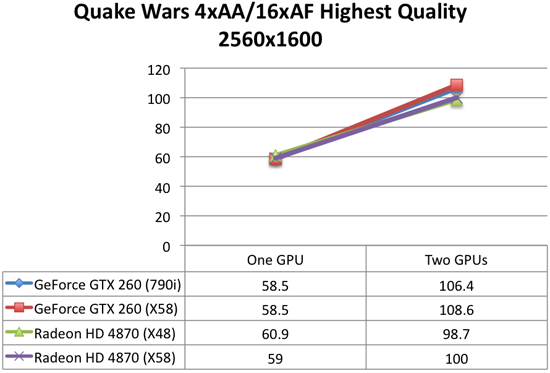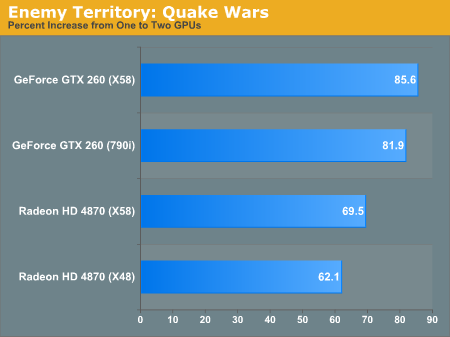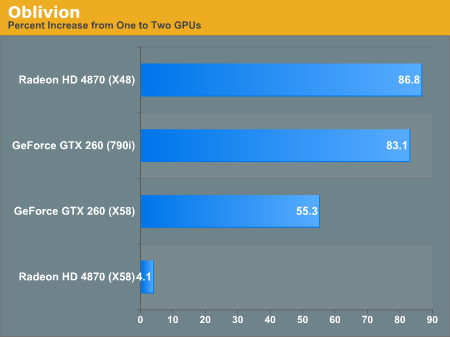The Dark Knight: Intel's Core i7
by Anand Lal Shimpi & Gary Key on November 3, 2008 12:00 AM EST- Posted in
- CPUs
X58 Multi-GPU Scaling
While we had some hope earlier in the year of unifying our SLI and CrossFire testbed under Skulltrail, we had to scrap that project due to numerous difficulties in testing. Today, we have another ray of hope. Having a single platform that will allow us to run both SLI and CrossFire would give us better ability to compare multiGPU scaling as there would be fewer variables to consider.
So we did a few tests today to see how the new X58 platform handles multiGPU scaling. We have compared CrossFire on X48 and SLI on 790i to multiGPU scaling on X58 in Oblivion and Quake Wars to get a taste of what we should expect. And the results are a bit of a mixed bag.


With Enemy Territory: Quake Wars, we see very consistent performance. Our single card numbers were very close to the numbers we saw on other platforms, and the general degree of scaling was maintained. Both NVIDIA and AMD hardware scaled slightly better on X58 here than on the hardware we had been using. This is a good sign that the potential for accurate comparison and good quality multiGPU testing might be possible on X58 going forward.
But there there's the Oblivion test.

Under Oblivion, NVIDIA hardware scaled less on X58, and our AMD tests were ... let's say inconclusive.

We have often had trouble with AMD drivers, especially when looking at CrossFire performance. The method that AMD uses to maintain and test their drivers necessitates eliminating some games from testing for extended periods of time. This can sometimes result in games that used to work well with AMD hardware or scale well with CrossFire to stop performing up to par or to stop scaling as well as they should.
The consistent fix, unfortunately, has been for review sites to randomly stumble upon these problems. We usually see resolutions very quickly to issues like this, but that doesn't change the fact that it shouldn't happen in the first place.
In any event, the past couple weeks have been more frustrating than usual when testing AMD hardware. We've switched drivers 4 different times in testing, and we still have issues. Yes, 3 of these four drivers have been hotfix beta drivers, but for people with Far Cry 2 the hotfix is all they've got, which is still broken even after three tries.
We certainly know that NVIDIA doesn't have it all right when it comes to drivers. But we really feel like AMD's monthly driver release schedule wastes resources on unnecessary work that could be better used to benefit their customers. If we are going to have hotfix drivers come out anyway, we might as well make sure that every full release incorporates all the fixes in every hot fix and doesn't break anything the last driver fixed.
The point of all this is, our money is on a lack of scaling under Oblivion due to some aspect of this beta driver we are using rather than scaling on X58.
As for the NVIDIA results, we're a little more worried about those. It could be that we are also seeing a driver issue here, but it just could be that Oblivion does something that doesn't scale well with SLI on X58. We were really surprised to see this as we expected comparable scaling. As the driers mature, we'll definitely test the issue of multiGPU scaling on X58 further.










73 Comments
View All Comments
Gary Key - Monday, November 3, 2008 - link
"The 920 to 3.6/3.8 is a nice overclock but I wonder what you mean by proper cooling and how close you came to crossing the 80C "boundary"?"It was actually quite easy to do with the retail cooler, in fact in our multi-task test playing back a BD title while encoding a BD title, the core temps hit 98C. Cinebench multi-core test and OCCT both had the core temps hit 100C at various points. Our tests were in a closed case loaded out with a couple of HD4870 cards, two optical drives, three hard drives, and two case fans.
Proper cooling (something we will cover shortly) consisted of the Thermalright Xtreme120, Vigor Monsoon II, and Cooler Master V8 along with the Freezone Elite. We were able to keep temps under 70C with a full load on air and around 45C with the Freezone unit.
Th3Eagle - Tuesday, November 4, 2008 - link
Wow, thats interesting. Can't wait to see the new article. Always nice to see an article about coolers.Thanks for the reply.
Anand Lal Shimpi - Monday, November 3, 2008 - link
Gary did the i7-920 tests so I'll let him chime in there, we're also working on an overclocking guide that should help address some of these concerns.-A
whatthehey - Monday, November 3, 2008 - link
Tom's? You might as well reference HardOCP....Okay, THG sometimes gets things right, but I've seen far too many "expose" articles where they talk about the end of the world to take them seriously. Ever since the i820 chipset fiasco, they seem to think everything is a big deal that needs a whistle blower.
Anandtech got 3.8GHz with an i7-920, and I would assume due diligence in performance testing (i.e. it's not just POSTing, but actually running benchmarks and showing a performance improvement). I'm still running an overclocked Q6600, though, and the 3.6GHz I've hit is really far more than I need most of the time. I should probalby run at 3.0GHz and shave 50-100W from my power use instead. But it's winter now, and with snow outside it's nice to have a little space heater by my feet!
The0ne - Monday, November 3, 2008 - link
TomHardware and Anandtech were the one websites I visited 13 years ago during my college years. Tom's has since been pushed far down the list of "to visit sites" mainly due to their poor articles and their ad littered, poorly designed website. If you have any type of no-script enable there's quite a bit to enable to have the website working. The video commentary is a joke as they're not professionals to get the job done professionally...visually anyhow.Anandtech has stayed true to it's root and although I find some articles a bit confusing I don't mind them at all. Example of this are camera reviews :)
GaryJohnson - Monday, November 3, 2008 - link
Geez, calling a core 2 a space heater. How soon we forget prescott...JarredWalton - Monday, November 3, 2008 - link
I think overclocked Core 2 Quad is still very capable of rating as a space heater. The chips can easily use upwards of 150W when overclocked, which if memory serves is far more than any of the Prescott chips did. After all, we didn't see 1000W PSUs back in the Prescott era, and in fact I had a 350W PSU running a Pentium D 920 at 3.4 GHz without any trouble. :-)Griswold - Tuesday, November 4, 2008 - link
Funny comparison. If it was just for the space heater arguments sake (well, 150W is by far not enough to qualify as a real space heater to be honest), I could follow you but saying the 150W of a 4 core, more-IPC-than-any-P4-can-ever-dream-of, processor should or could be compared to the wattage of the infamous thermonuclear furnace AKA prescott, is a bit of a long stretch, dont you think? :pRyan Smith - Monday, November 3, 2008 - link
Intel can call it supercalifragilisticexpialidocious until they're blue in the face, but take it from a local, it's Neh-Hay-Lem. Just see how it's pronounced in this news segment:http://www.katu.com/outdoors/3902731.html?video=YH...">http://www.katu.com/outdoors/3902731.html?video=YH...
mjrpes3 - Monday, November 3, 2008 - link
Any chance we'll see some database/apache benchmarks based on Nehalem soon?